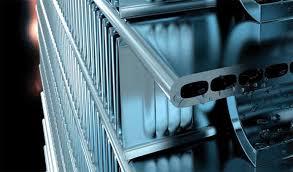Heat exchangers are a critical component in HVAC systems, automotive cooling, and industrial applications. As energy efficiency and environmental impact become more important, manufacturers and engineers face a choice: stick with traditional heat exchanger designs or move toward newer, more advanced options like microchannel coils. Each has its strengths, but which one ultimately comes out on top?
Traditional vs. Microchannel: The Core Design Differences
Traditional heat exchangers generally use round copper tubes with aluminum fins to facilitate heat transfer. This design has been around for decades and is trusted for its reliability. However, the modern alternative—microchannel heat exchangers—uses flat aluminum tubes with tiny internal channels that maximize surface area for heat transfer. These units are entirely constructed from aluminum, making them lighter and more resistant to galvanic corrosion. The switch to microchannel technology is gaining momentum, especially in industries focused on efficiency and compact design.
Efficiency and Performance Compared
When it comes to thermal performance, microchannel heat exchangers often have the upper hand. Their multiple small passages allow for greater heat transfer in a smaller space, which significantly improves efficiency. Traditional exchangers are effective but generally require more refrigerant and space to achieve the same output. Microchannel designs also offer lower pressure drops, leading to smoother refrigerant flow and reduced energy consumption. This translates to lower operating costs and improved system performance.
Material and Construction Advantages
One of the key differentiators between the two lies in their materials. Traditional heat exchangers use a combination of copper and aluminum, which can lead to galvanic corrosion over time. Microchannel models, on the other hand, are made entirely of aluminum, offering enhanced corrosion resistance and recyclability. This uniform material composition simplifies manufacturing and increases the coil’s overall lifespan. Additionally, the compact structure of microchannel exchangers makes them easier to transport and install.
Environmental and Regulatory Considerations
As environmental standards become more rigorous, the refrigerant charge used in HVAC systems is under intense scrutiny. Microchannel heat exchangers require significantly less refrigerant—up to 40% less—compared to their traditional counterparts. This not only meets regulatory guidelines but also helps companies and homeowners reduce their environmental footprint. For businesses striving for sustainability certifications, using microchannel systems can provide a crucial advantage.
Maintenance and Longevity
Both types of heat exchangers require maintenance, but microchannel models tend to be easier to clean due to their smooth aluminum surfaces. Traditional systems, with their fin-and-tube designs, are more prone to dirt accumulation and can be harder to service. Additionally, since microchannel exchangers are less susceptible to corrosion, they typically experience fewer leaks and last longer, reducing downtime and maintenance costs over time.
Cost Implications: Short-Term vs. Long-Term
In terms of initial cost, traditional heat exchangers might seem more budget-friendly. However, when you factor in energy savings, reduced refrigerant use, and lower maintenance costs, microchannel heat exchangers often provide better value in the long run. Their longer lifespan and regulatory advantages make them a smart investment for forward-thinking operations, even if the upfront costs are slightly higher.
Choosing between traditional and microchannel heat exchangers depends on your priorities. If you're looking for a time-tested solution with lower upfront costs, traditional exchangers still hold merit. However, if efficiency, environmental impact, and long-term savings matter most, microchannel heat exchangers are the clear winner. With their innovative design and performance benefits, they represent the future of thermal exchange technology in HVAC and beyond.
Introduction: A Shift in Heat Exchange Technology



